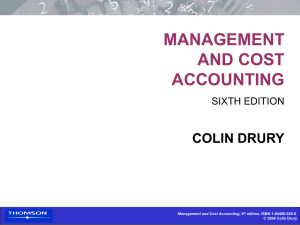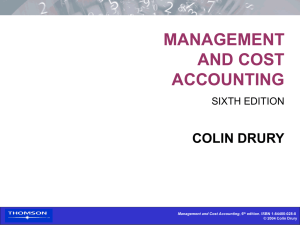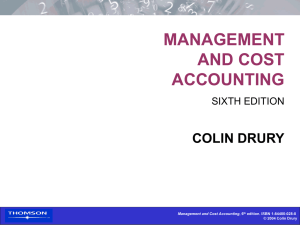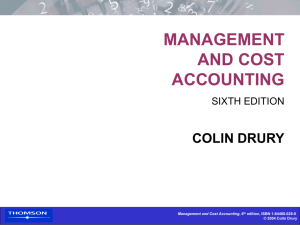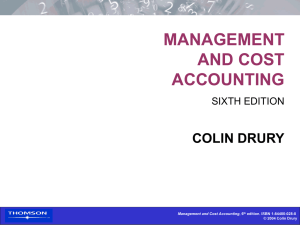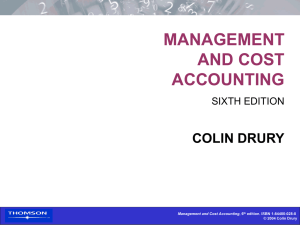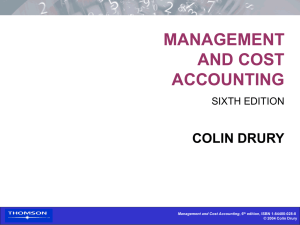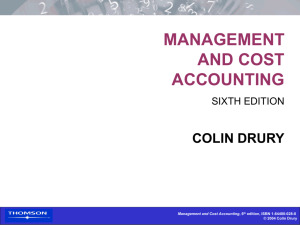Cost-volume-profit analysis
advertisement
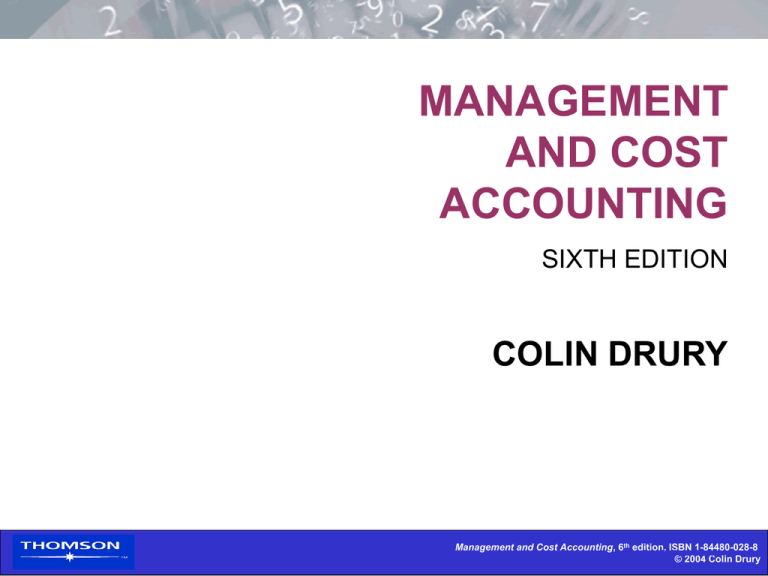
MANAGEMENT AND COST ACCOUNTING SIXTH EDITION COLIN DRURY Management and Cost Accounting, 6th edition, ISBN 1-84480-028-8 © 2000 Colin Drury © 2004 Colin Drury Part Three: Information for decision-making Chapter Eight: Cost-volume-profit analysis Management and Cost Accounting, 6th edition, ISBN 1-84480-028-8 © 2000 Colin Drury © 2004 Colin Drury 8.1 Economist’s cost-volume graph 1. Curvilinear graph results in two break-even points. 2. Note the shape of the total cost function: • initial steep rise, levels off, followed by a further steep rise. 3. The total revenue line initially rises steeply,then levels off and declines. Management and Cost Accounting, 6th edition, ISBN 1-84480-028-8 © 2000 Colin Drury © 2004 Colin Drury 8.2 Economist’s variable cost function 1. Output levels between 0 and Q1 = Increasing returns to scale 2. Output levels between Q1 and Q2 = Constant returns to scale 3. Output levels beyond Q2 = Decreasing returns to scale Management and Cost Accounting, 6th edition, ISBN 1-84480-028-8 © 2000 Colin Drury © 2004 Colin Drury 8.3a The accountant’s cost–volume–profit model 1. Constant variable cost and selling price is assumed. 2. Only one break-even point,and profit increases as volume increases. 3. The diagram is not intended to provide an accurate representation for all levels of output.The objective is to provide an accurate representation of cost and revenue behaviour only within the relevant range of output. Management and Cost Accounting, 6th edition, ISBN 1-84480-028-8 © 2000 Colin Drury © 2004 Colin Drury 8.3b Management and Cost Accounting, 6th edition, ISBN 1-84480-028-8 © 2000 Colin Drury © 2004 Colin Drury 8.4 Accountant’s fixed cost function 1. Within the short term the firm anticipates that it will operate between output levels Q2 and Q3 and commits itself to fixed costs of 0A. 2. Costs are fixed in the short term, but can be changed in the longer term. Management and Cost Accounting, 6th edition, ISBN 1-84480-028-8 © 2000 Colin Drury © 2004 Colin Drury 8.5a Management and Cost Accounting, 6th edition, ISBN 1-84480-028-8 © 2000 Colin Drury © 2004 Colin Drury 8.5b Changes in fixed costs 1. At the planning stage the firm must decide on how much productive capacity should be provided and,therefore,the level of fixed costs. 2. If maximum sales levels are 0Q1,0Q2 and 0Q3,then profits are maximized at output level 0Q2. 3. The firm will choose to provide capacity of 0Q2 and will operate on total cost line AB during the next period. Management and Cost Accounting, 6th edition, ISBN 1-84480-028-8 © 2000 Colin Drury © 2004 Colin Drury 8.6a Management and Cost Accounting, 6th edition, ISBN 1-84480-028-8 © 2000 Colin Drury © 2004 Colin Drury 8.6b Changes in selling price 1. At the planning stage prior to setting selling prices for the forthcoming period,the firm is considering whether to reduce the selling price in order to increase demand. 2. The potential revenue functions are 0A and 0C. 3. If anticipated demand is 0Q2 at the lower selling price and 0Q1 at the higher selling price,then the lower price will be selected and the firm will be committed to a revenue function of 0C during the next period. Management and Cost Accounting, 6th edition, ISBN 1-84480-028-8 © 2000 Colin Drury © 2004 Colin Drury 8.7a CVP analysis: non-graphical computations 1. Example 1 Fixed costs per annum Unit selling price Unit variable cost Relevant range 2. Break-even point Fixed costs Contribution per unit £60 000 £20 £10 4 000 - 12 000 units = £60 000/£10 = 6 000 units 3. Units to be sold to obtain a £30 000 profit: Fixed costs + desired profit = £90 000/£10 = 9 000 units Contribution per unit Management and Cost Accounting, 6th edition, ISBN 1-84480-028-8 © 2000 Colin Drury © 2004 Colin Drury 8.7b 4. If unit fixed costs and revenues are not given, the break-even point (expressed in sales values) can be calculated as follows: Total fixed costs Total contribution x Total sales 5. Profit volume ratio = Contribution Sales revenue x 100 6. Percentage margin of safety = Expected sales - Break-even sales Expected sales Management and Cost Accounting, 6th edition, ISBN 1-84480-028-8 © 2000 Colin Drury © 2004 Colin Drury 8.8 Break-even chart for Example 1 Management and Cost Accounting, 6th edition, ISBN 1-84480-028-8 © 2000 Colin Drury © 2004 Colin Drury 8.9 Contribution Chart for Example 1 Management and Cost Accounting, 6th edition, ISBN 1-84480-028-8 © 2000 Colin Drury © 2004 Colin Drury 8.10 Profit-volume graph for Example 1 Management and Cost Accounting, 6th edition, ISBN 1-84480-028-8 © 2000 Colin Drury © 2004 Colin Drury 8.11a CVP analysis assumptions 1. All other variables remain constant • e.g.sales mix, production efficiency, price levels, production methods. 2. Complexity-related fixed costs do not change. • If the range of items produced increases but volume remains unchanged, then it is assumed fixed costs will not alter. 3. Profits are calculated on a variable costing basis. 4. Unit variable cost and selling price are constant per unit of output. 5. The analysis applies over the relevant range only. 6. Costs can be accurately divided into their fixed and variable elements. 7. Single product or constant sales mix. Management and Cost Accounting, 6th edition, ISBN 1-84480-028-8 © 2000 Colin Drury © 2004 Colin Drury 8.11b Example Unit contribution Budgeted sales mix Actual sales mix Product X £12 50% 25% Product Y £8 50% 75% Fixed costs are £180 000 Budgeted BEP = £180 000 /£10 (a) = £18 000 units Actual BEP = £180 000 /£9 (b) = 20 000 units a (50% × £12) + (50% × £8) b (25% × £12) + (75% × £8) Management and Cost Accounting, 6th edition, ISBN 1-84480-028-8 © 2000 Colin Drury © 2004 Colin Drury
